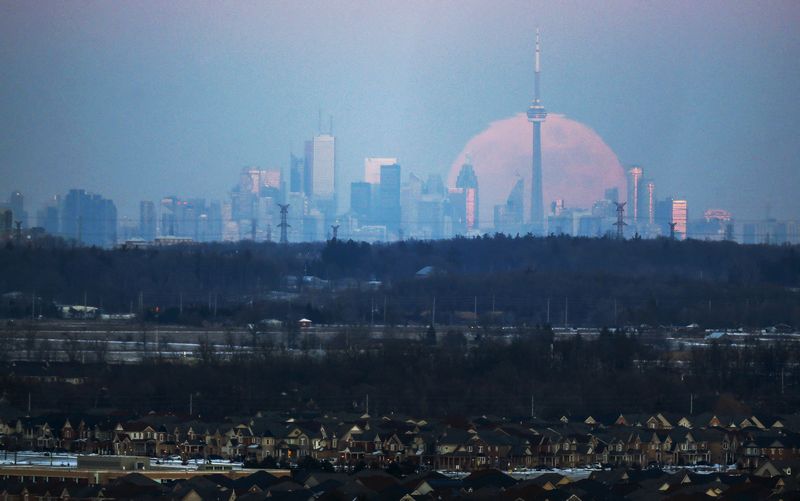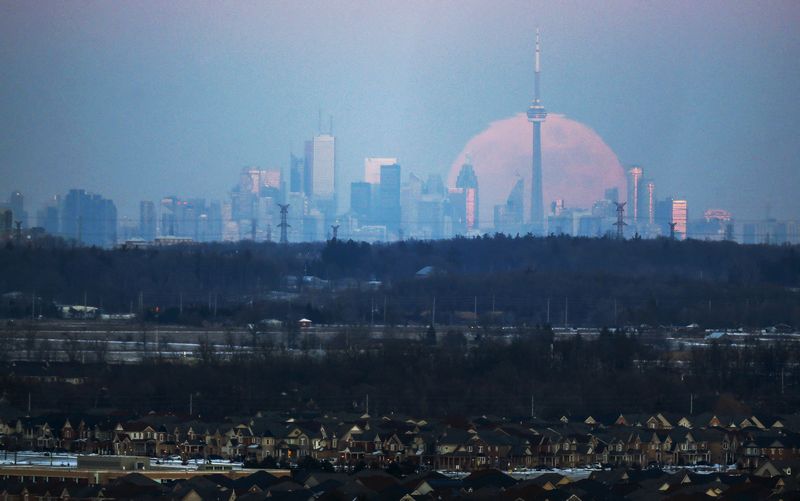Economy
Canadian banks see dip in 30 year-plus mortgages, but risks remain


© Reuters. FILE PHOTO: The moon rises over the Toronto city skyline as seen from Milton, Ontario, Canada, January 23, 2016. REUTERS/Mark Blinch
By Nivedita Balu
TORONTO (Reuters) – After a sharp rise in mortgage repayment terms over the past few quarters, Canadian banks’ home loans past 30 years have edged lower in the latest quarter but analysts say risks remain elevated with borrowing costs expected to stay higher for longer.
The Bank of Canada’s 10 interest rates since last year have triggered a spike in monthly payments for variable rate loans and in cases of fixed payments, their monthly contribution largely covered only the interest portion of their loan.
That has led to a rare situation in Canada where banks are seeing mortgage amortizations getting extended beyond 30 years, sparking calls from regulators to take immediate action to mitigate risks.
The big six banks said they have called on struggling customers giving them the option to switch to fixed-rate products, increase term payments or make a lump-sum payment as they hit the trigger rate.
For the top five banks offering variable-interest and fixed-payment options, that has resulted in mortgages with amortization of over 30 years dropping to between 23% and 29.8% in the three months ended July, from 25%-31% in the previous quarter.
When customers breach the trigger rate, all of their repayments go towards repaying interest, preparing them for a payment shock when mortgages come up for renewal. An estimated C$331 billion ($245 billion) in home loans are expected to come up for renewal next year alone.
CIBC’s CFO Hratch Panossian told Reuters in an interview that about 8,000 clients had increased their monthly payments and just over 1,000 clients made lump-sum payments, to remove their mortgage from the negative amortization status, as a result of the outreach during the third quarter.
“What we’re seeing in terms of behaviors within our clients is strong,” he added.
Canada’s total residential mortgage debt stood at C$2 trillion at the start of the year. CIBC, with its domestic focus, is one of the most exposed to the mortgage market and at end July, about 56% of its variable mortgage book only received interest payment.
Bank of Nova Scotia, the only bank among Canada’s top five to offer variable payments for its floating rate customers, had only about 1% of its overall residential mortgages amortize over 30 years, while loans amortizing between 20 and 29 years fell to 65.5% from 67.4% in the February-April quarter.
For the other four banks, mortgages amortizing under 25 years account for a half to nearly three quarters.
Scotiabank’s Canada head Dan Rees said the bank was now being more “disciplined with regards to customer selection” for new mortgages.
Still, the risks remain elevated as consumers are struggling to make monthly payments due to the rising cost of living.
“The very fact that banks are proactive … speaks to the fact that this is sort of a front-page issue, a household concern, a political concern,” said Brian Madden, the chief investment officer at First Avenue Investment Counsel.
“The ones that adjust on renewal, they are just kicking the can down the road and the reset will be probably bigger when they renew.”
TD Bank’s Canada personal banking head Michael Rhodes told analysts this week that “a meaningful number of customers” are making the changes.
While not all banks allow negative amortization, consumers have to adjust their repayments in line with rising interest rates.
“The industry has a significant portion of mortgages maturing in 2024, 2025 … If rates hold, we’ll pull more disposable income out of the economy and slow it even faster,” RBC’s CEO Dave McKay said.
($1 = 1.3508 Canadian dollars)
(This story has been refiled to say ‘to offer’ instead of ‘not offer,’ in paragraph 10)
Economy
Russian central bank says it needs months to make sure CPI falling before rate cuts -RBC


© Reuters. Russian Central Bank Governor Elvira Nabiullina attends a news conference in Moscow, Russia June 14, 2019. REUTERS/Shamil Zhumatov/File Photo
MOSCOW (Reuters) – Russia’s central bank will need two to three months to make sure that inflation is steadily declining before taking any decision on interest rate cuts, the bank’s governor Elvira Nabiullina told RBC media on Sunday.
The central bank raised its key interest rate by 100 basis points to 16% earlier in December, hiking for the fifth consecutive meeting in response to stubborn inflation, and suggested that its tightening cycle was nearly over.
Nabiullina said it was not yet clear when exactly the regulator would start cutting rates, however.
“We really need to make sure that inflation is steadily decreasing, that these are not one-off factors that can affect the rate of price growth in a particular month,” she said.
Nabiullina said the bank was taking into account a wide range of indicators but primarily those that “characterize the stability of inflation”.
“This will take two or three months or more – it depends on how much the wide range of indicators that characterize sustainable inflation declines,” she said.
The bank will next convene to set its benchmark rate on Feb. 16.
The governor also said the bank should have started monetary policy tightening earlier than in July, when it embarked on the rate-hiking cycle.
Economy
China identifies second set of projects in $140 billion spending plan


© Reuters. FILE PHOTO: Workers walk past an under-construction area with completed office towers in the background, in Shenzhen’s Qianhai new district, Guangdong province, China August 25, 2023. REUTERS/David Kirton/File Photo
SHANGHAI (Reuters) – China’s top planning body said on Saturday it had identified a second batch of public investment projects, including flood control and disaster relief programmes, under a bond issuance and investment plan announced in October to boost the economy.
With the latest tranche, China has now earmarked more than 800 billion yuan of its 1 trillion yuan ($140 billion) in additional government bond issuance in the fourth quarter, as it focuses on fiscal steps to shore up the flagging economy.
The National Development and Reform Commission (NDRC) said in a statement on Saturday it had identified 9,600 projects with planned investment of more than 560 billion yuan.
China’s economy, the world’s second largest, is struggling to regain its footing post-COVID-19 as policymakers grapple with tepid consumer demand, weak exports, falling foreign investment and a deepening real estate crisis.
The 1 trillion yuan in additional bond issuance will widen China’s 2023 budget deficit ratio to around 3.8 percent from 3 percent, the state-run Xinhua news agency has said.
“Construction of the projects will improve China’s flood control system, emergency response mechanism and disaster relief capabilities, and better protect people’s lives and property, so it is very significant,” the NDRC said.
The agency said it will coordinate with other government bodies to make sure that funds are allocated speedily for investment and that high standards of quality are maintained in project construction.
($1 = 7.1315 renminbi)
Economy
Russian central bank says it needs months to make sure CPI falling before rate cuts -RBC


© Reuters. Russian Central Bank Governor Elvira Nabiullina attends a news conference in Moscow, Russia June 14, 2019. REUTERS/Shamil Zhumatov/File Photo
MOSCOW (Reuters) – Russia’s central bank will need two to three months to make sure that inflation is steadily declining before taking any decision on interest rate cuts, the bank’s governor Elvira Nabiullina told RBC media on Sunday.
The central bank raised its key interest rate by 100 basis points to 16% earlier in December, hiking for the fifth consecutive meeting in response to stubborn inflation, and suggested that its tightening cycle was nearly over.
Nabiullina said it was not yet clear when exactly the regulator would start cutting rates, however.
“We really need to make sure that inflation is steadily decreasing, that these are not one-off factors that can affect the rate of price growth in a particular month,” she said.
Nabiullina said the bank was taking into account a wide range of indicators but primarily those that “characterize the stability of inflation”.
“This will take two or three months or more – it depends on how much the wide range of indicators that characterize sustainable inflation declines,” she said.
The bank will next convene to set its benchmark rate on Feb. 16.
The governor also said the bank should have started monetary policy tightening earlier than in July, when it embarked on the rate-hiking cycle.

 Forex2 years ago
Forex2 years agoForex Today: the dollar is gaining strength amid gloomy sentiment at the start of the Fed’s week

 Forex2 years ago
Forex2 years agoHow is the Australian dollar doing today?

 Forex1 year ago
Forex1 year agoUnbiased review of Pocket Option broker

 Forex2 years ago
Forex2 years agoDollar to pound sterling exchange rate today: Pound plummeted to its lowest since 1985

 Cryptocurrency2 years ago
Cryptocurrency2 years agoWhat happened in the crypto market – current events today

 World2 years ago
World2 years agoWhy are modern video games an art form?

 Stock Markets2 years ago
Stock Markets2 years agoMorgan Stanley: bear market rally to continue

 Economy2 years ago
Economy2 years agoCrude oil tankers double in price due to EU anti-Russian sanctions

































